CORMORANTS & SHAGS
West Dunbartonshire has two main waterways - the Clyde and the Leven. The former is also the area's coastline as it becomes the Firth of Clyde and from there, the Atlantic. These, these together with various reservoirs, present great environments for water birds such as these.
Both cormorants and shags are large, dark water birds. They are very similar, but the shag is found along the coast north of here and only very occassionally in inland waters. You are unlikely to see one in West Dunbartonshire. What you are very likely to see is a cormorant, usually alone, perched on a log or rock outcrop, wings held out to warm and dry them.
While simply known to most of us as the "cormorant" to differentiate from other species found elsewhere it can be identified as the ‘Great cormorant’ or ‘Atlantic great cormorant’. It is the largest of all living cormorant species in Europe. However, a rarer, but an increasingly frequent visitor to Scotland is the continental great cormorant or sub-species Phalacrocorax carbo sinensis.
GREAT CORMORANTS : Phalacrocorax carbo carbo and Phalacrocorax senesis
To most of us these are the same bird and it is too technical to try to be sure which is which. They are both great comorants. For a more specific descriptio see the link to Bird Guides below. Roughly speaking, the former likes coastal waters and the latter inland fresh waters.
They are quite large birds. What appears to be two different species is the slightly different colouration between the fully adult and the younger ones. The adults are black all over and the younger ones have a whitish or pale grey front.
They are excellent divers, hunting for fish below the surface. This efficiency has meant they are disliked by fishermen. When resting they can be found perched on logs or rock outcrops, sometimes with their wings outstretched to dry and warm them.
They usually nest on cliff ledges, although sometimes also in large trees near expanses of water. While usually seen alone in our local waters, they may gather in large numbers.
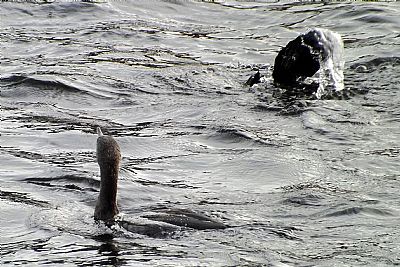
A pair of cormorants hunt for breakfast in the fast flowing water below the Leven barrage in September. Blink and they have disappeared.
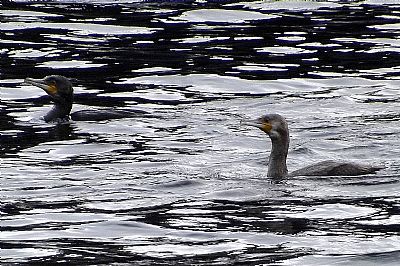
You may notice that one is slightly lighter in colour than the other. This is indicative of it being younger.
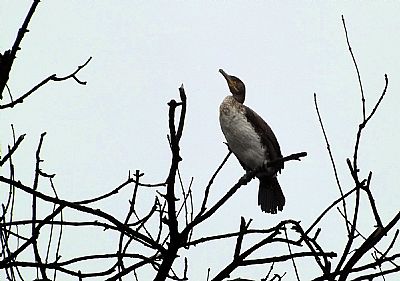
You will usually see cormorants sitting on logs or rock faces. This young one decided to perch high up on a dead tree above the Leven, possibly to keep some distance from walkers on the towpath.
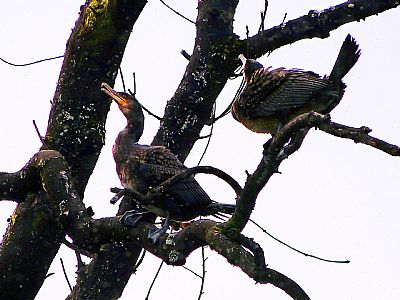
The same favourite roosting tree on the upper Leven in September. Two of three cormorants are preening. Another is flying off down the river.
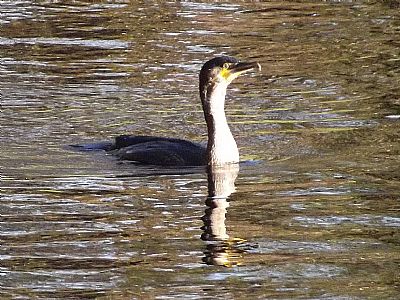
A young white fronted cormorant in the Leven in November.
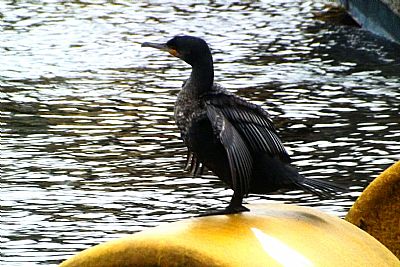
Its a cold winter morning, cloudy and damp. But this bird is optimistically holding its wings open to warm and dry them.
In November 2023 a dead cormorant. presumably one of those pictured above, was found on the grass near the Stuckie Bridge. Every wild creature dies sometime, but surely if this was a natural death it would have fallen into the strong current and swept downstream or into the undergrowth below its favourite tree perch lower down. Was it killed intentionally by anglers in jeolous misinterpretation of its fishing skills? Or perhaps uninterionally if it got fangled in an angler's line, possibly catching the same fish.
Anglers have been seen to torment a seal in a very rare visit up here for similar jeolousies and sworn at the energetic and highlyt skilled goosanders, smaller so less likely to take the bigger fish. The introduction of beavers in the Ettrick Water send some into fowl mood....
The villifying of the cormorant is ages old. But it is felt to be wrongly based by some experts. "The cormorant is sometimes managed by culling, due to its perceived overfishing and tree destruction. But defenders of this common water bird suggest maybe it's humans and their cultural assumptions that are the source of the problem". For more on this see the article linked below under CBC.
The article dows note the concern that cormorants damage trees. Our local ones that frequent the upper Leven habitually roost in a large leafless tree. Perhaps their occupation including guano does denude this tree, but on the other hand cormorants choose bare trees to roost in.
BIRD GUIDES website : https://www.birdguides.com/articles/identification/great-and-double-crested-cormorants-and-european-shag-photo-id-guide/
RSPB : https://www.rspb.org.uk/birds-and-wildlife/wildlife-guides/bird-a-z/cormorant/
SCOTTISH WILDLIFE TRUST : https://scottishwildlifetrust.org.uk/species/cormorant/

